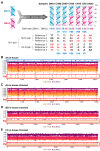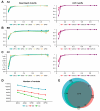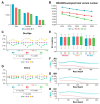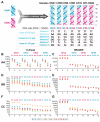Enhancing Clinical Applications by Evaluation of Sensitivity and Specificity in Whole Exome Sequencing
- PMID: 39769013
- PMCID: PMC11678496
- DOI: 10.3390/ijms252413250
Enhancing Clinical Applications by Evaluation of Sensitivity and Specificity in Whole Exome Sequencing
Abstract
The cost-effectiveness of whole exome sequencing (WES) remains controversial due to variant call variability, necessitating sensitivity and specificity evaluation. WES was performed by three companies (AA, BB, and CC) using reference standards composed of DNA from hydatidiform mole and individual blood at various ratios. Sensitivity was assessed by the detection rate of null-homozygote (N-H) alleles at expected variant allelic fractions, while false positive (FP) errors were counted for unexpected alleles. Sensitivity was approximately 20% for in-house results from BB and CC and around 5% for AA. Dynamic Read Analysis for GENomics (DRAGEN) analyses identified 1.34 to 1.71 times more variants, detecting over 96% of in-house variants, with sensitivity for common variants increasing to 5%. In-house FP errors varied significantly among companies (up to 13.97 times), while DRAGEN minimized this variation. Despite DRAGEN showing higher FP errors for BB and CC, the increased sensitivity highlights the importance of effective bioinformatic conditions. We also assessed the potential effects of target enrichment and proposed optimal cutoff values for the read depth and variant allele fraction in WES. Optimizing bioinformatic analysis based on sensitivity and specificity from reference standards can enhance variant detection and improve the clinical utility of WES.
Keywords: WES; cancer; false negative error; false positive error; mutation; quality control; reference standard.
Conflict of interest statement
The authors declare no conflicts of interest.
Figures







Similar articles
-
Improved Diagnostic Yield in Recessive Intellectual Disability Utilizing Systematic Whole Exome Sequencing Data Reanalysis.Clin Genet. 2025 Jun;107(6):612-619. doi: 10.1111/cge.14692. Epub 2025 Jan 2. Clin Genet. 2025. PMID: 39748273
-
Benchmarking of variant calling software for whole-exome sequencing using gold standard datasets.Sci Rep. 2025 Apr 21;15(1):13697. doi: 10.1038/s41598-025-97047-7. Sci Rep. 2025. PMID: 40258889 Free PMC article.
-
A comparative study of single nucleotide variant detection performance using three massively parallel sequencing methods.PLoS One. 2020 Sep 28;15(9):e0239850. doi: 10.1371/journal.pone.0239850. eCollection 2020. PLoS One. 2020. PMID: 32986766 Free PMC article.
-
Whole exome sequencing in inborn errors of immunity: use the power but mind the limits.Curr Opin Allergy Clin Immunol. 2017 Dec;17(6):421-430. doi: 10.1097/ACI.0000000000000398. Curr Opin Allergy Clin Immunol. 2017. PMID: 28938278 Review.
-
Whole exome sequencing of cell-free DNA - A systematic review and Bayesian individual patient data meta-analysis.Cancer Treat Rev. 2020 Feb;83:101951. doi: 10.1016/j.ctrv.2019.101951. Epub 2019 Dec 13. Cancer Treat Rev. 2020. PMID: 31874446
References
MeSH terms
Grants and funding
LinkOut - more resources
Full Text Sources
Miscellaneous

